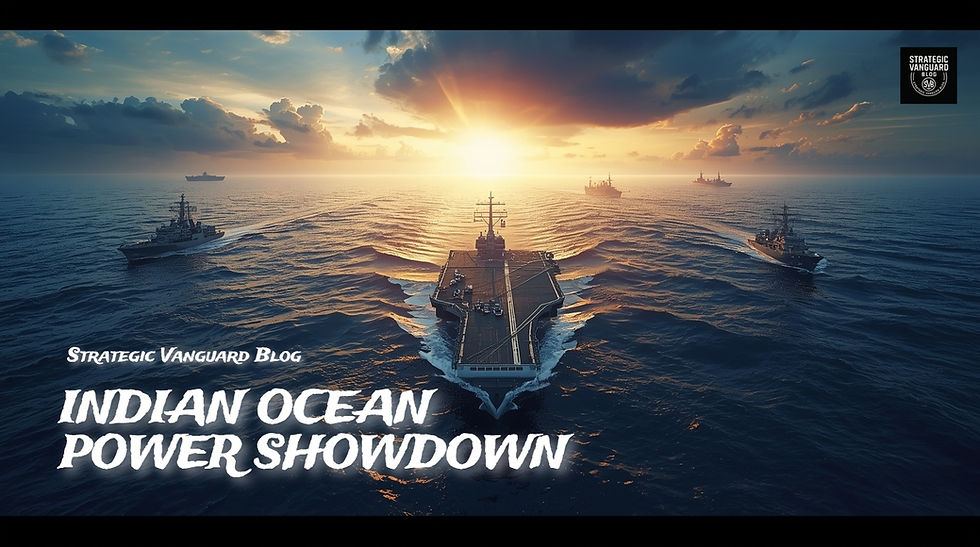India’s Military-Industrial Revolution: Can We Finally End Foreign Defense Dependence?
- Manoj Ambat

- Jul 12
- 3 min read

Introduction: The Strategic Shift India Can’t Ignore
India has long stood at the crossroads of ambition and dependency. Despite its global stature and growing security needs, the nation has remained one of the world’s largest arms importers—until now.
A quiet revolution is unfolding: India is investing in a full-fledged military-industrial complex. Fighter jets like Tejas, warships like INS Vikrant, and missiles like BrahMos are just the beginning. But is this the turning point in India's quest for strategic autonomy?
🕰️ A Legacy of Dependency: How India Became the World's Top Arms Importer
For decades, India’s military was heavily dependent on foreign suppliers—first the Soviet Union, then Russia, France, the U.S., and Israel. While this brought cutting-edge systems like the MiG-21, Rafale, and S-400, it also left India vulnerable to:
Delayed deliveries
Sanctions threats (e.g., CAATSA)
Limited control over upgrades
Lack of supply chain sovereignty
From the 1971 war to the 2020 Galwan standoff, India's strategic community has learned that military preparedness must be rooted in independence.
🏗️ Atmanirbhar Bharat: The Defense Doctrine of Self-Reliance
In 2020, the Indian government launched Atmanirbhar Bharat Abhiyan (Self-Reliant India Mission), placing defense at the core of national transformation.
Key reforms include:
Positive Indigenisation Lists: Banning imports of hundreds of defense items
Increased R&D for DRDO and indigenous weapon systems
Strategic Partnership Model to bring in private sector giants like Tata, Adani, and L&T
Procurement policy changes favoring local manufacturing
This marks a major shift: India is not just buying weapons—it’s now building them.
✈️ What India Is Building: Land, Air, Sea & Strategic Systems
Air Power:
Tejas Mk1A in full production
AMCA: India’s 5th-generation stealth fighter in development
Indigenous UAVs like Rustom-II and Ghatak
Naval Power:
INS Vikrant: India’s first indigenous aircraft carrier
Ongoing indigenous destroyers, corvettes, and submarine projects
Land Systems:
Arjun Mk1A tanks, Pinaka rocket systems, and AK-203 rifles in joint production
AI-integrated defense tech by Indian startups
Missiles & Strategic Platforms:
BrahMos: Export success and upgraded variants
Agni and Astra missile systems for nuclear and conventional deterrence
🧩 The Private Sector Enters the Battlefield
India’s historically PSU-dominated defense landscape is now opening up. Major private players are investing in manufacturing, R&D, and even exports.
Tata Advanced Systems is building UAVs and radar systems
L&T is a leader in warship construction
Adani Defence is entering missile systems, drones, and avionics
Dozens of startups are working on battlefield AI, sensors, and tactical systems
This is not just industrial reform—it’s a geopolitical pivot.
⚠️ Challenges to Watch
Despite the momentum, several issues persist:
Delays and inefficiency in DRDO-led projects
Bureaucratic red tape and lack of inter-agency coordination
Reluctance of the armed forces to fully trust indigenous systems
Need for deep-tier supply chains and IP protection
To succeed, India needs policy continuity, strategic discipline, and end-user faith in homegrown innovation.
🌏 Strategic Implications: Why This Revolution Matters
A strong defense manufacturing base isn’t just about weapons—it’s about:
Sovereignty over critical systems
Strategic autonomy in a multipolar world
Defense diplomacy via arms exports to Africa, Southeast Asia, and Latin America
Boosting the Indian economy through high-tech jobs and dual-use innovation
India has the opportunity to emerge as a geopolitical balancer, armed not only with policy but with homegrown power.
🧭 Conclusion: The Road Ahead
India’s military-industrial revolution is real—but it’s still in its early chapters. With the right alignment of government, industry, and the armed forces, India could transition from being the world’s top arms importer to a respected global defense manufacturer by 2040.
The stakes are high. But so is the potential.
Visit us at :
Our website- https://strategicvanguard.com/
Strategic Vanguard @ Youtube- https://www.youtube.com/@strategicvanguard
Strategic Vanguard @ Facebook: https://www.facebook.com/strategicvanguard
Strategic Vanguard @X (Formerly Twitter)- https://x.com/StrategicVangu1
Strategic Vanguard @ Instagram- https://www.instagram.com/strategicvanguard/
Strategic Vanguard @ Quora- https://strategicvanguard.quora.com/
Strategic Vanguard @ Medium: https://medium.com/@strategicvanguard1
Strategic Vanguard @ Reddit- https://www.reddit.com/r/strategicvanguard/
To watch the complete video, click here:



Comments